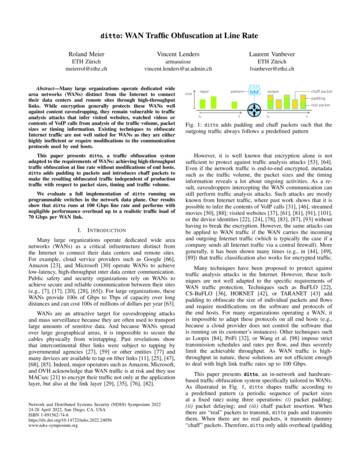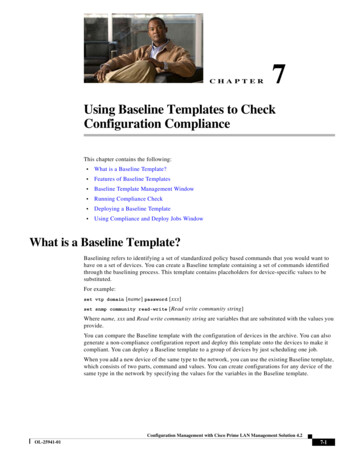
Transcription
Baseline TestingBy Johann du PlessisDecember 2009
Baseline Testing[Type text]Baseline TestingIntroductionBaseline tests form a very important part of the performance test methodology I follow. If done properly,85% of performance problems can be identified and solved when proper baseline tests are done. Recentexperiences on three different projects show this figure to be closer to 90%. This really has me veryexcited about the whole idea and implementation of baseline testing.What is the baseline testing referred to here? Why and how are baseline tests executed? What is in placeduring these tests? How do baseline tests differ from other performance tests? In this article I’ll answerthese and some other questions about baseline testing.Why Baseline Tests?The main advantage of running proper baseline tests is the time that is saved by this. Performancetesting is a complex process and most often enough time is not available for proper test cycles. The timeproblem often leads to less baseline tests being done, but over time I’ve learnt that this is not the place totry and save time. In fact, baseline testing is where time can be saved.A performance test project should at least include baseline and load tests. If possible a stress test andsome volume and soak (endurance) testing should also be included. There should be a clearunderstanding of each test type. The table below describes each type of performance testing with theterminology I use in my methodology.Performance TestingType of testingDescriptionBaselineDone for each script with 1, 2, 5, 10, 20 and 50users to determine baselines for mainly responsetimes.LoadTest system with multiple users to determineperformance under load. The number of users isusually specified by the performance testrequirements.StressLoad the system to its breakpoint. This is todetermine the system break point or threshold.How the system breaks and recovers should alsobe monitored.Soak (Endurance)Testing a system under load for an extended periodof time to establish stability and behavior undersustained use.VolumeTesting a system with a certain amount of data.Usually includes high data and throughputvolumes.When I started performance testing 9 years ago I learnt about and was trained with the term “loadtesting”. Sometimes people referred to or used the term “stress testing” and I was told not to worry, it’s thesame thing. Today people still use mainly those two terms. The focus is definitely still on load testing and2Copyright 2009 Micro to Mainframe
Baseline Testing[Type text]there’s nothing wrong with that. The end goal should always be a system that performs well under load.The way we get there is what matters.Preparing for and executing a load test can be a tedious task. A lot of project time is spent on thepreparation for load test execution. Data setup and management is one of the main areas that take a lotof the tester’s time. Scripting, data preparation, linking data to scripts, scenario planning andconfiguration, test environment preparation and monitoring all form part of the preparation before a loadtest can be executed. Once everything is in place the test is started, but it seldom happens that the firstload test is a success. Most of the time numerous errors occur and some users will pass while others failuntil all users eventually fail. The result is usually a big mess within a very short time and data that tookhours to prepare will have to be prepared again. Monitoring also becomes a nightmare with differenterrors experienced in different places. The result of this is very busy graphs that are difficult to interpret ascan be seen on the example below.The problem here is that a lot of time is needed before the next test can be run and it can take a lot oftime before something useful can be extracted from the test results. More useful results are needed in ashorter space of time and that’s what baseline testing delivers.Useful Results QuicklyHaving useful results to show quickly is a bonus on any project. As mentioned before the preparation fora load test can take a long time. During this time people will be waiting impatiently for the first test results.If the results aren’t very useful or take a long time to analyze, the situation can become difficult tomanage. On the other hand, if the first results are available after a short time and easy to read andinterpret, you will find a lot of happy people around you that will support you for the rest of the project.This, plus the fact that you don’t have to spend hours and hours to get ready for the next test run, is thereal benefit of baseline tests. At the same time you also get the actual baseline results for the tests andcan report on this immediately.Preparation for baseline tests doesn’t take as long as preparation for load tests. Test data is not neededin large volumes and the hardware and software requirements to execute the tests are easily achieved.The results are easy to read and reports can be done very quickly. If a problem shows up during the3Copyright 2009 Micro to Mainframe
Baseline Testing[Type text]baseline testing this is identified easily and can be isolated at the same time. Isolating problems that showon busy graphs usually takes a long time, but with baseline tests a lot of time is saved with this as well.Executing Baseline TestsIdeally baseline tests should be done with 1, 2, 5, 10, 20 and 50 users. This should be done for eachscript that will be part of the load test individually and immediately isolates any problems that might occur.The baseline tests should run for 20 to 30 minutes to get useful averages. Fight for time to do this andmake it part of your script and load test preparation. The baseline tests give everyone a clear view ofsystem performance and save a lot of time with identifying and isolating the causes of problems. Largevolumes of test data is not lost with every failed test run and preparation for the next test can becompleted quickly. Use these facts to motivate the need for proper baseline tests. When done properly,you’ll need a lot less time for the load testing.The goal to work for is to start the first load test only after all the problems identified during baselinetesting have been resolved. This opens the opportunity to have an almost perfect run when executing thefirst load test. Errors encountered during the load test will nearly all be load related with other problemsalready fixed during the baseline tests.MonitoringAs with all performance testing, proper monitoring should be done during the baseline testing. Withoutproper monitoring you often have to repeat a test if a problem is encountered to be able to identify what iswrong where. I always keep a close eye on monitoring throughout the performance testing. This gives mea very good feel for the system and I can pick up very quickly if something is not right at any point duringany test. Include all the responsible people right from the start. Meaningful results can’t be extractedwithout proper monitoring.Examples – Baseline Test ResultsLet’s look at some examples to put everything into perspective.The first series of graphs show average transaction response times for a script that captures customerdetails. The graphs are for 1, 5, 20 and 50 users. In this example a problem was identified with a specificstep, Search Postal Code, which had to be fixed before the actual load test with 500 users could be done.The data preparation for this script was horrendous with a lot of unique data that could only be used once.Starting with a 500 user load test would have caused many headaches.The Search Postal Code transaction is highlighted in red on each graph.4Copyright 2009 Micro to Mainframe
Baseline TestingCapture Details – 1 User5Copyright 2009 Micro to Mainframe[Type text]
Baseline TestingCapture Details – 5 Users6Copyright 2009 Micro to Mainframe[Type text]
Baseline TestingCapture Details – 20 Users7Copyright 2009 Micro to Mainframe[Type text]
Baseline Testing[Type text]Capture Details – 50 UsersThe degradation in performance from 1 to 50 users can clearly be seen. With 50 users the systemeventually crashed. The advantage of the baseline tests are graphs with limited measurements where theproblem transaction can be easily identified. If this was run with other scripts and numerous othermeasurements, isolating the problem could have been really difficult.These results were available early in the project and justified the importance of the performance testingimmediately. Looking good early on helps to gain respect and trust from the right people for the rest of theproject.8Copyright 2009 Micro to Mainframe
Baseline Testing[Type text]The next example shows the importance of having monitoring in place during the baseline testing. In thisexample a search function caused the system to crash with 30 users. The requirement was to have asuccessful 1000 user test at the end of the performance testing. The time saved by running baseline testsfor each individual script on this specific project was enormous. Problems as the one in the example wereidentified in 3 out of 7 scripts. If all the scripts were run together and with load, finding and isolating theproblems responsible for the system crash would have been very difficult and time consuming.The 30 user test for the search function failed when the users received time-outs as can be seen on thegraph below. The graph shows the transaction response times with the running users.Running Users vs. Average Response Time (users left axis, response times right axis)The system resources showed very high CPU usage on the application server when users performed thesearch function. The graph below shows the CPU utilization of the application server as well as thedatabase server during the 30 user test that failed. Note the low CPU usage on the database comparedto the application server9Copyright 2009 Micro to Mainframe
Baseline Testing[Type text]Running Users vs. System Resources (users left axis, CPU percentage right axis)Resource monitoring helped to identify the problem quickly. As in the first example, these results could bereported on early and meaningful results were distributed soon after the start of the testing effort. Theimportance of having monitoring in place at all times is highlighted once again.SummaryWith numerous successes as shown in the examples above, baseline testing has proven itself as anessential part of the performance testing process. The time saved by finding and isolating problems earlyon is enormous. Showing good, meaningful results early on a project has many advantages. It highlightsthe importance of performance testing and showing the improvements when problems are fixed make therest of the project a very positive experience.Include baseline tests in your planning and leave enough time for this. Do it properly, don’t take anyshortcuts. The benefits are great and when the actual load testing begins, the system will already performwell. You will also know the system well by then and will be able to see changes in trends or performanceimmediately. This makes the testing just that much better and you a better performance tester.10Copyright 2009 Micro to Mainframe
baseline testing this is identified easily and can be isolated at the same time. Isolating problems that show on busy graphs usually takes a long time, but with baseline tests a lot of time is saved with this as well. Executing Baseline Tests Ideally baseline tests should be done with 1, 2, 5, 10, 20 and 50 users. This should be done for each










